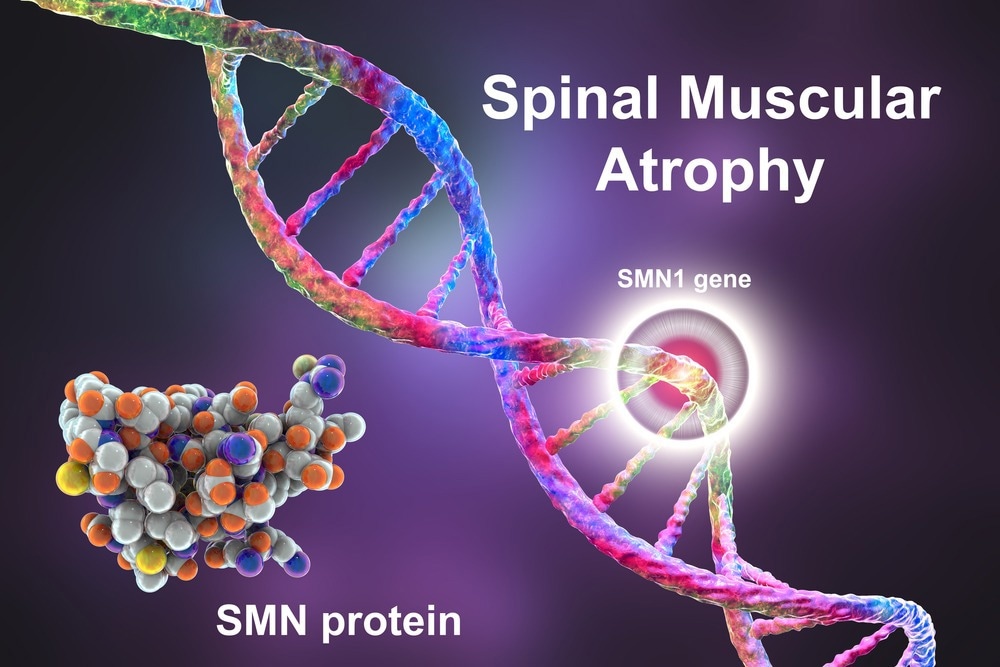Introduction
SMA Type 0
SMA Type 1
SMA Type 2
SMA Type 3
SMA Type 4
References
Spinal muscular atrophy (SMA) is a genetic neuromuscular condition caused by mutations in the SMN1 gene.
SMA is characterized by symmetrical progressive (proximal predominant) muscle atrophy caused by lower motor neuron degeneration in the anterior spinal horns and brain nuclei. Several types of SMA are now recognized based upon the maximum motor function that the patient has and the age of onset.
At first, SMA diagnoses consisted of three types, presented at the International Consortium on Spinal Muscular Atrophy in 1991. The third type was later modified to contain two subtypes, while a fourth type was added as well as a type 0 for the most severe cases beginning in antenatal life and with an invariably fatal onset.
Despite this, it is now well known that the so-called types of SMA are not watertight compartments but rather a continuum within which even manifestations thought to belong to the same type may vary significantly in severity. The importance of the classification scheme remains, however, due to its ability to provide a basis for comparison and make an accurate prognosis.

Image Credit: Kateryna Kon/Shutterstock.com
SMA Type 0
Newborns are typically affected by this type, being born with severe hypotonia and muscular weakness and retrospectively being recognized to have very few fetal movements during intrauterine life. Prenatal muscular atrophy is thus common.
Examination findings include areflexia, facial paralysis, heart defects (atrial septal defects), and joint contractures (due to hypotonia in intrauterine life). Respiratory failure is common, and most affected babies die within six months.
SMA Type 1
This category originally included what is now sometimes called type 0 or type 1a. However, type 1, also called Werdnig-Hoffman disease, now consists of the most severe form of SMA, which is also the most frequently seen, comprising 45% of patients. Onset is usually within six months of birth.
The infant may appear quite normal but quickly develops:
- Hypotonia
- Limb weakness
- Lack of head control
- Areflexia or hyporeflexia
- Weak cry
- Poor feeding with tongue fasciculations and difficulty in swallowing due to bulbar motor neuron degeneration
- Breathing trouble
Secondary to the hypotonic weakness of some muscles with sparing of others, the baby may show:
- Characteristic frog-leg posture of the lower limbs
- Bell deformity of the chest due to diaphragmatic sparing with intercostal weakness
- Paradoxical breathing in which the chest wall moves inward on inhalation due to the above cause
Intelligence and memory are high to normal. The child cannot sit up, and in most cases, death occurs before the second birthday is reached. Respiratory distress is a common cause of death, and intensive supportive care may prolong life in these infants.
Some experts further divide type 1 into types a, b and c in order of decreasing severity. Thus, type 1a refers to type 0. Type 1b refers to babies who are initially normal but develop signs of weakness within two months before ever achieving head control. Type 1c refers to children who show hypotonic weakness after the neonatal period after achieving head control, and a few may even sit up, which is against the definition of this type.
Understanding Spinal Muscular Atrophy (SMA)
SMA Type 2
In children with type 2 SMA, who make up a fifth of the total, independent sitting typically occurs within nine months but can sometimes be late. . However, children are unable to walk unassisted. The proximal limb weakness is more pronounced in the arms. It sets in during the period between about 6 and 18 months.
The child also manifests:
- Hypotonia
- Areflexia
- Minipolymyoclonus (fine tremor in the distal part of the limbs)
- Tongue fasciculations and atrophy
- Chewing difficulties
- Respiratory difficulty, especially towards the severe end of this category
- Normal cognitive processes
Complications due to hypotonia include:
- Joint contractures
- Progressive scoliosis (in almost all patients in this category)
- Mandibular stiffness and ankylosis
- Restrictive lung disease because of scoliosis with weakness of intercostal musculature
Most patients with type 2 SMA live to 25 years and beyond, especially with better medical support.
SMA Type 3
Type 3 SMA, or Kugelberg-Welander disease, occurs in about 30% of patients and manifests between 18 months and adult life. These patients can achieve unassisted standing and walking initially, though the progression of symptoms may deprive them of these abilities later. Weakness affects the lower limbs more than the upper limbs.
This is further subdivided into type 3a, in which children are diagnosed between 18 months and three years, and type 3b, where patients are older than three years and younger than 30 years at onset. The usual presentation is frequent falls, trouble climbing stairs, and gait abnormalities to compensate for the proximal weakness. Type 3 patients usually live as long as unaffected people.
Rarely scoliosis and respiratory dysfunction can occur. Obesity and osteoporosis may complicate the clinical course in patients with greater loss of function, limiting mobility. This is more common with type 3b patients.
SMA Type 4
Type 4 SMA was originally a subtype at the mild end of type 3, confined to about 5% of SMA patients. These individuals can walk well into adulthood and are diagnosed much later, at 30 years or older. Related problems, such as swallowing and respiratory difficulties, are absent.
References:
- Kolb SJ, Kissel JT. Spinal Muscular Atrophy. Neurol Clin. 2015 Nov;33(4):831-46. doi: 10.1016/j.ncl.2015.07.004. PMID: 26515624; PMCID: PMC4628728.
- Kolb SJ, Kissel JT. Spinal muscular atrophy: a timely review. Arch Neurol. 2011 Aug;68(8):979-84. doi: 10.1001/archneurol.2011.74. Epub 2011 Apr 11. PMID: 21482919; PMCID: PMC3860273.
- Arnold WD, Kassar D, Kissel JT. Spinal muscular atrophy: diagnosis and management in a new therapeutic era. Muscle Nerve. 2015 Feb;51(2):157-67. doi: 10.1002/mus.24497. Epub 2014 Dec 16. PMID: 25346245; PMCID: PMC4293319.
- D'Amico A, Mercuri E, Tiziano FD, Bertini E. Spinal muscular atrophy. Orphanet J Rare Dis. 2011 Nov 2;6:71. doi: 10.1186/1750-1172-6-71. PMID: 22047105; PMCID: PMC3231874.
Further Reading